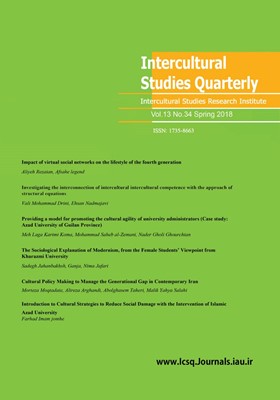-
-
List of Articles
-
Open Access Article
1 - Impact of Virtual Social Networks on the Lifestyle of the Fourth Generation (the Eighties) - Emphasizing Telegram, Instagram and Twitter
alie rezaiyan afsaneh edrisi -
Open Access Article
2 - Investigating the Interconnection of Intercultural Competence With the Approach of Structural Equations
vali mohammad darini ehsan namdar joyami -
Open Access Article
3 - Providing a Model for Promoting the Cultural Agility of University Administrators (Case Study: Islamic Azad University of Guilan Province)
Mah Legha Karimi Koma Mohammad Sahebalzamani nadergholi ghorchian -
Open Access Article
4 - The Sociological Explanation of Fashionism, From the Female Students’ Viewpoint in Kharazmi University
sadegh jahanbakhshganjeh nima jafari -
Open Access Article
5 - Cultural Policy Making to Manage the Generational Gap in Contemporary Iran
Morteza Moghtadai Alireza Azghandi Abolghasem Taheri Malek yahya Salahi -
Open Access Article
6 - Introduction to Cultural Strategies to Reduce Social Damage with the Intervention of Islamic Azad University
farhad emamjome
-
The rights to this website are owned by the Raimag Press Management System.
Copyright © 2021-2025







